Hugo W.B., Russel A.D.(ed). Pharmaceutical Microbiology
Подождите немного. Документ загружается.

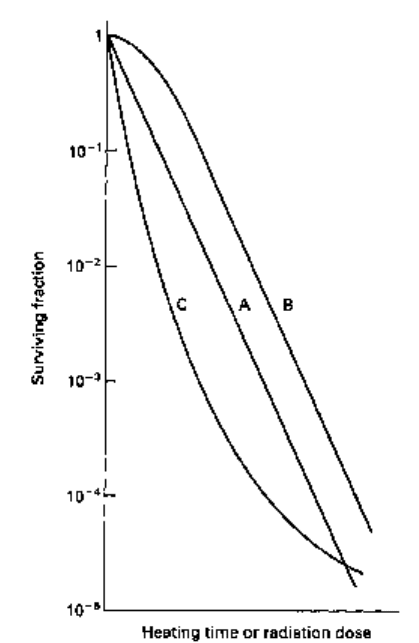
Fig. 20.1 Typical survivor
curves for bacterial spores
exposed to moist heat or
gamma-radiation.
Expressions of resistance
D-value
The resistance of an organism to a sterilizing agent can be described by means of the
D-value. For heat and radiation treatments, respectively, this is defined as the time
taken at a fixed temperature or the radiation dose required to achieve a 90% reduction
in viable cells (i.e. a 1 log cycle reduction in survivors; Fig. 20.2A). The calculation of
the D-value assumes a linear type A survivor curve (Fig. 20.1), and must be corrected
to allow for any deviation from linearity with type B or C curves. Some typical D-
values for resistant bacterial spores are given in Table 23.2 (Chapter 23).
z-value
For heat treatment, a D-value only refers to the resistance of a microorganism at a
particular temperature. In order to assess the influence of temperature changes on thermal
resistance a relationship between temperature and log D-value can be developed leading
to the expression of a z-value, which represents the increase in temperature needed to
reduce the D-value of an organism by 90% (i.e. 1 log cycle reduction; Fig. 20.2B). For
bacterial spores used as biological indicators for moist heat (B. stearothermophilus)
Principles and practice of sterilization 387
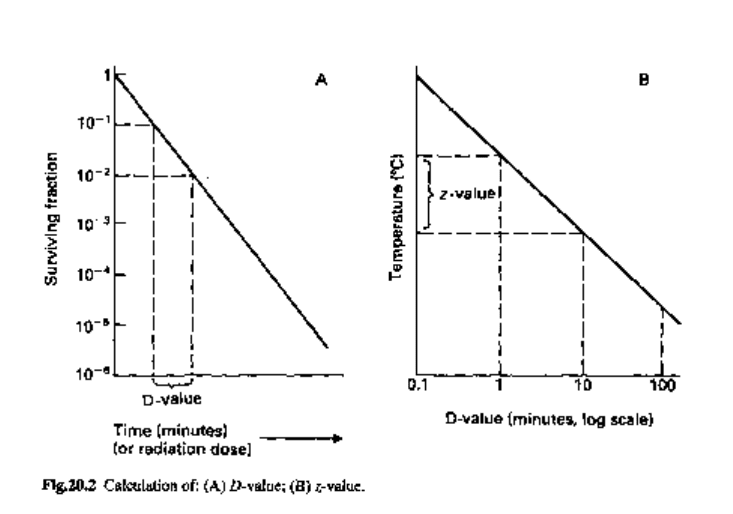
and dry heat (B. subtilis) sterilization processes, mean z-values are given as 10°C and
22°C, respectively. The z-value is not truly independent of temperature but may be
considered essentially constant over the temperature ranges used in heat sterilization
processes.
2.3
Sterility assurance
The term 'sterile', in a microbiological context, means no surviving organisms
whatsoever. Thus, there are no degrees of sterility; an item is either sterile or it is not,
and so there are no levels of contamination which may be considered negligible or
insignificant and therefore acceptable.
From the survivor curves presented, it can be seen that the elimination of viable
microorganisms from a product is a time-dependent process, and will be influenced by
the rate and duration of biocidal action and the initial microbial contamination level. It
is also evident from Fig. 20.2A that true sterility, represented by zero survivors, can
only be achieved after an infinite exposure period or radiation dose. Clearly, then, it is
illogical to claim, or expect, that a sterilization procedure will guarantee sterility. Thus,
the likelihood of a product being produced free of microorganisms is best expressed in
terms of the probability of an organism surviving the treatment process, a possibility
not entertained in the absolute term 'sterile'. From this approach has arisen the concept
of sterility assurance or a microbial safety index which gives a numerical value to the
probability of a single surviving organism remaining to contaminate a processed product.
For pharmaceutical products, the most frequently applied standard is that the probability,
post-sterilization, of a non-sterile unit is ^1 in 1 million units processed (i.e. =sl0
-6
).
The sterilization protocol necessary to achieve this with any given organism of known
D-value can be established from the inactivation factor (IF) which may be defined as:
IF = 10*°
388 Chapter 20
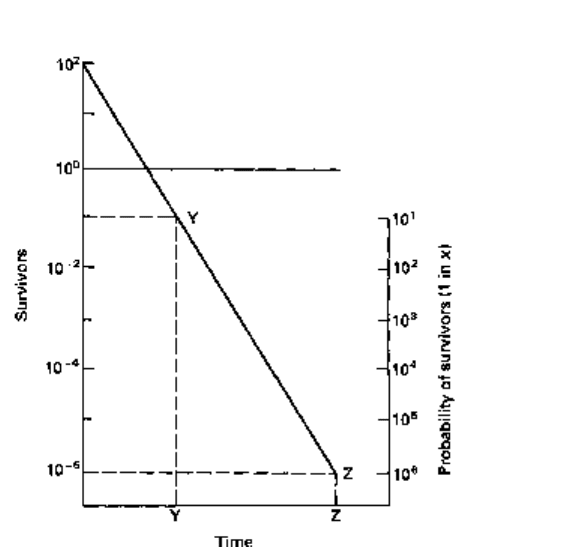
Fig. 20.3 Sterility assurance. At Y, there is (literally) 10"
1
bacterium in one bottle, i.e. in 10 loads of
single containers, there would be one chance in 10 that one load would be positive. Likewise, at Z,
there is (literally) 10
-6
bacterium in one bottle, i.e. in 1 million (10
6
) loads of single containers, there
is one chance in 1 million that one load would be positive.
where t is the contact time (for a heat or gaseous sterilization process) or dose (for
ionizing radiation) and D is the D-value appropriate to the process employed.
Thus, for an initial burden of 10
2
spores an inactivation factor of 10
8
will be needed
to give the required sterility assurance of 10
-6
(Fig. 20.3). The sterilization process will
therefore need to produce sufficient lethality to achieve an 8 log cycle reduction in
viable organisms; this will require exposure of the product to eight times the D-value
of the reference organism (8D). In practice, it is generally assumed that the contaminant
will have the same resistance as the test spores unless full microbiological data are
available to indicate otherwise. The inactivation factors associated with certain
sterilization protocols and their biological indicator organisms (Chapter 23) are given
in Table 20.1.
3 Sterilization methods
The British Pharmacopoeia (1993) recognizes five methods for the sterilization of
pharmaceutical products. These are: (i) dry heat; (ii) heating in an autoclave (steam
sterilization); (iii) filtration; (iv) ethylene oxide gas; and (v) gamma or electron radiation.
In addition, other approaches involving steam and formaldehyde and ultraviolet (UV)
light have evolved for use in certain situations. For each method, the possible
permutations of exposure conditions are numerous, but experience and product stability
Principles and practice of sterilization 389

requirements have generally served to limit this choice. Nevertheless, it should be
remembered that even the recommended methods and regimens do not necessarily
demonstrate equivalent biocidal potential, but simply offer alternative strategies for
application to a wide variety of product types. Thus, each should be validated in their
application to demonstrate that the minimum required level of sterility assurance can
be achieved (section 2.3 and Chapter 23).
In the following sections, factors governing the successful use of these sterilizing
methods will be covered and their application to pharmaceutical and medical products
considered. Methods for monitoring the efficacy of these processes are discussed in
Chapter 23.
4 Heat sterilization
Heat is the most reliable and widely used means of sterilization, affording its
antimicrobial activity through destruction of enzymes and other essential cell
constituents. These lethal events proceed at their most rapid in a fully hydrated state,
thus requiring a lower heat input (temperature and time) under conditions of high
humidity where denaturation and hydrolysis reactions predominate, rather than in the
dry state where oxidative changes take place. This method of sterilization is limited to
thermostable products, but can be applied to both moisture-sensitive and moisture-
resistant products for which the British Pharmacopoeia (1993) recommends dry (160-
180°C) and moist (121-134°C) heat sterilization, respectively. Where thermal
degradation of a product might possibly occur, it can usually be minimized by selecting
the higher temperature range since the shorter exposure times employed generally result
in a lower fractional degradation.
4.1 Sterilization process
In any heat sterilization process, the articles to be treated must first be raised to
sterilization temperature and this involves a heating-up stage. In the traditional approach,
timing for the process (the holding time) then begins. It has been recognized, however,
that during both the heating-up and cooling-down stages of a sterilization cycle (Fig.
20.4), the product is held at an elevated temperature and these stages may thus contribute
to the overall biocidal potential of the process.
390 Chapter 20
Table 20.1 Inactivation factors (IF) for selected sterilization protocols and their correspond
biological indicator (BI)
Sterilization protocol
Moist heat
<121°Cfor 15 minutes)
Dry heat
(160°Cfor2 hours)
Irradiation
(25kGy;2.5Mrad)
organisms
BI organism D-value
B. stearothermophilus 1.5min
B. subtilis Max. 10min
var. niger
B. pumilus 3 kGy (0.3 Mrad)
ing
IF
10
Min. 12
8.3
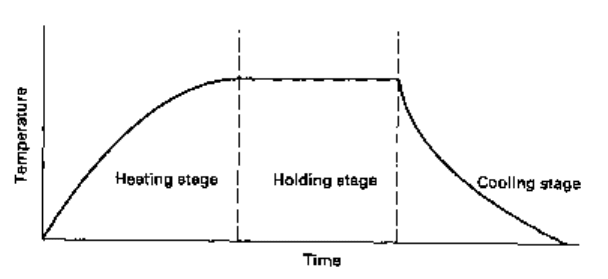
Fig. 20.4 Typical temperature profile of a heat sterilization process.
A method has been devised to convert all the temperature-time combinations
occurring during the heating, sterilizing and cooling stages of a moist heat (steam)
sterilization cycle to the equivalent time at 121 °C. This involves following the
temperature profile of a load, integrating the heat input (as a measure of lethality), and
converting it to the equivalent time at the standard temperature of 121°C. Using this
approach the overall lethality of any process can be deduced and is defined as the F-
value, which expresses heat treatment at any temperature as equal to that of a certain
number of minutes at 121 °C. In other words, if a moist heat sterilization process has an
F-value of x, then it has the same lethal effect on a given organism as heating at 121 °C
for x minutes, irrespective of the actual temperature employed or of any fluctuations in
the heating process due to heating and cooling stages. The F-value of a process will
vary according to the moist heat resistance of the reference organism; when the reference
spore is that of B. stearothermophilus with a z-value of 10°C, then the F-value is known
as the F
0
-value.
A relationship between F- and D-values, leading to an assessment of the probable
number of survivors in a load following heat treatment, can be established from the
following equation:
F = F>(log;V
0
-logAO
in which D is the D-value at 121 °C, and iV
0
and N represent, respectively, the initial and
final number of viable cells per unit volume.
The F-concept has evolved from the food industry and principally relates to the
sterilization of articles by moist heat. Because it permits calculation of the extent to
which the heating and cooling phases contribute to the overall killing effect of the
autoclaving cycle, the F-concept enables a sterilization process to be individually
developed for a particular product. This means that adequate sterility assurance can be
achieved in autoclaving cycles in which the traditional pharmacopoeial recommendation
of 15 min at 121
Q
C is not achieved. The holding time may be reduced below ,15 min if
there is a substantial killing effect during the heating and cooling phases, and an adequate
cycle can be achieved even if the 'target' temperature of 121 °C is not reached. Thus, F-
values offer both a means by which alternative sterilizing cycles can be compared in
terms of their microbial killing efficiency, and a mechanism by which over-processing
of marginally thermolabile products can be reduced without compromising sterility
Principles and practice of sterilization 391
assurance. They have found application in the sterilization of medical and pharmaceutical
products by moist heat where, for aqueous preparations, the British Pharmacopoeia
(1993) generally requires a minimum F
0
-value of 8 from a steam sterilization process.
There is an apparent anomaly in that it also states that the 'preferred' combination
of temperature and time is a minimum of 121 °C maintained for 15 minutes, which, by
definition, equates to an F
0
value of 15. The latter, however, is applicable where the
material to be sterilized may contain relatively large numbers of thermophilic bacterial
spores, and an F
0
of 8 is appropriate for a 'microbiologically validated' process where
the bioburden is low and the spores likely to be present are those of (the generally more
heat sensitive) mesophilic species.
F
Q
values may be calculated either from the 'area under the curve' of a plot of
autoclave temperature against time constructed using special chart paper on which the
temperature scale is modified to take into account the progressively greater lethality of
higher temperatures, or by use of the equation below:
F
0
= AtZW
T
-
m
^
where At = time interval between temperature measurements; T = product temperature
at time t; z is (assumed to be) 10°C.
Thus, if temperatures were being recorded from a thermocouple at 1.00 minute
intervals then At= 1.00, and a temperature of, for example, 115°C maintained for
1 minute would give an F
Q
value of 1 minute x 10
(115
~
121)/10
which is equal to 0.251
minutes. In practice, such calculations could easily be performed on the data from
several thermocouples within an autoclave using PC-driven software, and, in a
manufacturing situation, these would be part of the batch records. Such a calculation
facility is offered as an optional extra by most autoclave manufacturers.
Application of the F- value concept has been largely restricted to steam sterilization
processes although there is a less frequently employed, but direct parallel in dry heat
sterilization (see section 4.3).
4.2 Moist heat sterilization
Moist heat has been recognized as an efficient biocidal agent from the early days of
bacteriology, when it was principally developed for the sterilization of culture media.
It now finds widespread application in the processing of many thermostable products
and devices. In the pharmaceutical and medical sphere it is used in the sterilization of
dressings, sheets, surgical and diagnostic equipment, containers and closures, and
aqueous injections, ophthalmic preparations and irrigation fluids, in addition to the
processing of soiled and contaminated items (Chapter 21).
Sterilization by moist heat usually involves the use of steam at temperatures in the
range 121-134°C, and while alternative strategies are available for the processing of
products unstable at these high temperatures, they rarely offer the same degree of sterility
assurance and should be avoided if at all possible. The elevated temperatures generally
associated with moist heat sterilization methods can only be achieved by the generation
of steam under pressure.
By far the most commonly employed standard temperature/time cycles for bottled
fluids and porous loads (e.g. surgical dressings) are 121 °C for 15 minutes and 134°C
392 Chapter 20

Table 20.2 Pressure-temperature relationships and antimicrobial efficacies of alternative steam
sterilization cycles
Temperature
(°C)
115
121
126
134
Holding time
(minutes)
30
15
10
3
Steam
(kPa)
69
103
138
207
pressure
(psi)
10
15
20
30
Inactivation factor*
(decimal reductions)
5.2
10
21
40
* Calculated for a spore suspension having a D
l2l
of 1.5 minutes and a Z value of 10°C.
for 3 minutes, respectively. Not only do high temperature-short time cycles often result
in lower fractional degradation (see section 4), they also afford the advantage of
achieving higher levels of sterility assurance due to greater inactivation factors (Table
20.2). The 115°C for 30 minute cycle was considered an acceptable alternative to 121 °C
for 15 minutes prior to the publication of the 1988 British Pharmacopoeia, but it is no
longer considered sufficient to give the desired sterility assurance levels for products
which may contain significant concentrations of thermophilic spores.
4.2.1 Steam as a sterilizing agent
To act as an efficient sterilizing agent, steam should be able to provide moisture and
heat efficiently to the article to be sterilized. This is most effectively done using saturated
steam, which is steam in thermal equilibrium with the water from which it is derived,
i.e. steam on the phase boundary (Fig. 20.5). Under these circumstances, contact with
a cooler surface causes condensation and contraction drawing in fresh steam and leading
to the immediate release of the latent heat, which represents approximately 80% of the
heat energy. In this way heat and moisture are imparted rapidly to articles being sterilized
and dry porous loads are quickly penetrated by the steam.
Steam for sterilization can either be generated within the sterilizer, as with portable
bench or 'instrument and utensil' sterilizers, in which case it is constantly in contact
with water and is known as 'wet' steam, or can be supplied under pressure (350-400kPa)
from a separate boiler as 'dry' saturated steam with no entrained water droplets. The
killing potential of 'wet' steam is the same as that of 'dry' saturated steam at the same
temperature, but it is more likely to soak a porous load creating physical difficulties for
further steam penetration. Thus, major industrial and hospital sterilizers are usually
supplied with 'dry' saturated steam and attention is paid to the removal of entrained
water droplets within the supply line to prevent introduction of a water 'fog' into the
sterilizer.
If the temperature of 'dry' saturated steam is increased, then, in the absence of
entrained moisture, the relative humidity or degree of saturation is reduced and the
steam becomes superheated (Fig. 20.5). During sterilization this can arise in a number
of ways, for example by overheating the steam jacket (see section 4.2.2), by using too
dry a steam supply, by excessive pressure reduction during passage of steam from the
boiler to the sterilizer chamber, and by evolution of heat of hydration when steaming
Principles and practice of sterilization 393
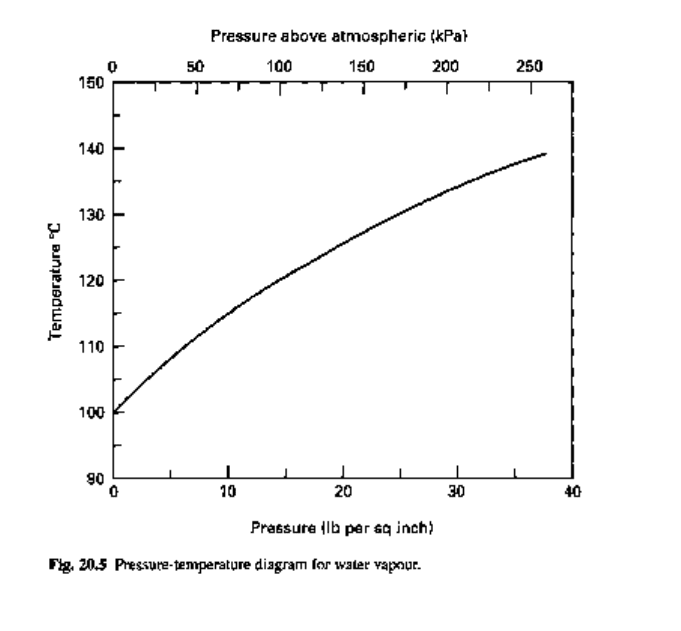
over-dried cotton fabrics. Superheated steam behaves in the same manner as hot air
since condensation and release of latent heat will not occur unless the steam is cooled
to the phase boundary temperature. Thus, it proves to be an inefficient sterilizing agent,
and although a small degree of transient superheating can be tolerated, a maximum
acceptable level of 5°C superheat is set, i.e. the temperature of the steam is never
greater than 5°C above the phase boundary temperature at that pressure.
The relationship between temperature and pressure holds true only in the presence
of pure steam; adulteration with air contributes to a partial pressure but not to the
temperature of the steam. Thus, in the presence of air the temperature achieved
will reflect the contribution made by the steam and will be lower than that normally
attributed to the total pressure recorded. Addition of further steam will raise the
temperature but residual air surrounding articles may delay heat penetration or, if a
large amount of air is present, it may collect at the bottom of the sterilizer, completely
altering the temperature profile of the sterilizer chamber. It is for these reasons that
efficient air removal is a major aim in the design and operation of a boiler-fed steam
sterilizer.
4.2.2 Sterilizer design and operation
Steam sterilizers, or autoclaves as they are sometimes known, are stainless steel vessels
designed to withstand the steam pressures employed in sterilization. They can be: (i)
394 Chapter 20
'portable' sterilizers, where they generally have internal electric heaters to produce
steam and are used for small pilot or laboratory-scale sterilization and for the treatment
of instruments and utensils; or (ii) large-scale sterilizers for routine hospital or industrial
use, operating on 'dry' saturated steam from a separate boiler (Fig. 20.6). Because of
their widespread use within pharmacy this latter type will be considered in greatest
detail.
There are two main types of large sterilizers, those designed for use with porous
loads (i.e. dressings) and generally operated at a minimum temperature of 134°C, and
those designed as bottled-fluid sterilizers employing a minimum temperature of 121 °C.
The stages of operation are common to both and can be summarized as air removal and
steam admission, heating-up and exposure, and drying or cooling. Many modifications
of design exist and in this section only general features will be considered. Fuller
treatments of sterilizer design and operation can be found in Health Technical
Memorandum 2010 (1994).
General design features. Steam sterilizers are constructed with either cylindrical or
oblong chambers, with preferred capacities ranging from 400 to 800 litres. They can be
sealed by either a single door or by doors at both ends (to allow through-passage of
processed materials; see Chapter 22, section 3.2.3). During sterilization the doors are
held closed by a locking mechanism which prevents opening when the chamber is
under pressure and until the chamber has cooled to a pre-set temperature, typically
80°C.
In the larger sterilizers the chamber may be surrounded by a steam-jacket which
can be used to heat the autoclave chamber and promote a more uniform temperature
throughout the load. The same jacket can also be filled with water at the end of the
cycle to facilitate cooling and thus reduce the overall cycle time. The chamber floor
slopes towards a discharge channel through which air and condensate can be removed.
Temperature is monitored within the opening of the discharge channel and by
thermocouples in dummy packages; jacket and chamber pressures are followed using
pressure gauges. In hospitals and industry, it is common practice to operate sterilizers
on an automatic cycle, each stage of operation being controlled by a timer responding
to temperature- or pressure-sensing devices.
Operation
1 Air removal and steam admission. Air can be removed from steam sterilizers either
by downward displacement with steam, evacuation or a combination of the two. In the
downward displacement sterilizer, the heavier cool air is forced out of the discharge
channel by incoming hot steam. This has the benefit of warming the load during air
removal which aids the heating-up process. It finds widest application in the sterilization
of bottled fluids where bottle breakage may occur under the combined stresses of
evacuation and high temperature. For more air-retentive loads (i.e. dressings), however,
this technique of air removal is unsatisfactory and mechanical evacuation of the air is
essential before admission of the steam. This can either be to an extremely high level
(e.g. 2.5 kPa) or can involve a period of pulsed evacuation and steam admission, the
latter approach improving air extraction from dressings packs. After evacuation, steam
penetration into the load is very rapid and heating-up is almost instantaneous. It is
Principles and practice of sterilization 395
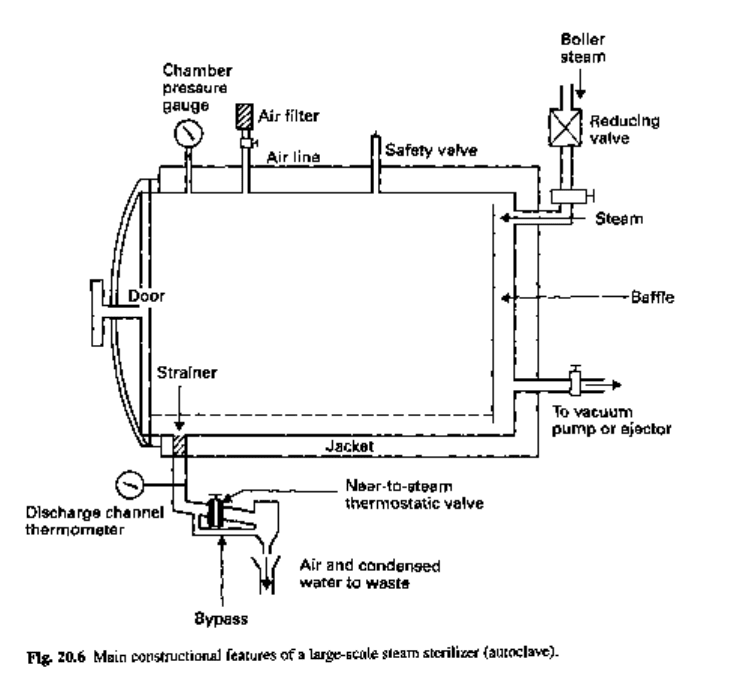
axiomatic that packaging and loading of articles within a sterilizer be so organized as
to facilitate air removal.
During the sterilization process, small pockets of entrained air may still be released,
especially from packages, and this air must be removed. This is achieved with a near-
to-steam thermostatic valve incorporated in the discharge channel. The value operates
on the principle of an expandable bellows containing a volatile liquid which vaporizes
at the temperature of saturated steam thereby closing the valve, and condenses on the
passage of a cooler air-steam mixture, thus reopening the valve and discharging the
air. Condensate generated during the sterilization process can also be removed by this
device. Small quantities of air will not, however, lower the temperature sufficiently to
operate the valve and so a continual slight flow of steam is maintained through a bypass
around the device in order to flush away residual air.
It is common practice to package sterile fluids, especially intravenous fluids, in
flexible plastic containers. During sterilization these can develop a considerable internal
pressure in the airspace above the fluid and it is therefore necessary to maintain a
proportion of air within the sterilizing chamber to produce sufficient overpressure to
prevent these containers from bursting (air ballasting). In sterilizers modified or designed
to process this type of product, air removal is therefore unnecessary but special attention
must be paid to the prevention of air 'layering' within the chamber. This is overcome
by the inclusion of a fan or through a continuous spray of hot water within the chamber
